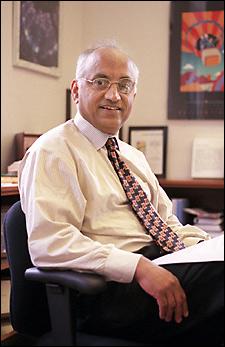DEAS, physical sciences dean to step down in 2006
Venkatesh Narayanamurti plans to concentrate on teaching, research

Venkatesh Narayanamurti has announced his intention to step down in June 2006 as dean of the Division of Engineering and Applied Sciences (DEAS) and dean for physical sciences in the Faculty of Arts and Sciences (FAS) at Harvard University. Narayanamurti, the John A. and Elizabeth S. Armstrong Professor of Engineering and Applied Sciences, plans to devote himself to teaching, research, and other forms of university service.
“I am tremendously grateful to Dean Venky for his leadership and many accomplishments as dean of DEAS and dean for physical sciences,” said William C. Kirby, Edith and Benjamin Geisinger Professor of History and dean of the Faculty of Arts and Sciences. “He has fostered substantial growth and renewal in these critical areas through the successful recruitment of new junior- and senior-level faculty and by helping us to launch and sustain new research initiatives that have had a substantial impact within FAS and across the University. He has produced new synergy between the departments in the physical sciences and the DEAS. Thanks to Venky, planning for future growth across the physical sciences and in DEAS is well under way. I commend and thank Venky for his tremendously energetic and effective service. Beyond all this, he has been a wise and valued counselor to me on all matters of importance to our faculty.”
“Venky’s energetic leadership has brought new vitality and excitement to Harvard’s expanding efforts in engineering and the applied sciences, and to planning and progress in the sciences more generally,” said President Lawrence H. Summers. “I join his many admirers across Harvard and beyond in thanking him for all he has done and continues to do.”
Kirby said that a search for a successor would begin early this summer. Narayanamurti, who joined Harvard as DEAS dean in 1998, assumed his appointment as FAS dean for the physical sciences on Sept. 1, 2003.
“The Division of Engineering and Applied Sciences is in a critical period of growth, and I am confident that after eight years of expansion I will be leaving it strong and well-positioned for new leadership at this exciting and important time,” Narayanamurti said. “I am grateful to former Dean Jeremy Knowles for recruiting me to Harvard. I am proud of my accomplishments and would like to thank President Summers, Provost Hyman, and Dean Kirby for their strong support and the opportunity to shape and further strengthen the physical sciences and engineering at Harvard.”
As dean, Narayanamurti has been a tireless builder and ambassador. The DEAS faculty is now 50 percent larger than it was when he was named dean in 1998, with faculty productivity and satisfaction fostered through new research funding; mentoring for junior colleagues; and staff support to facilitate grants and contracts, communications, information technology, and development. Narayanamurti built new bridges to colleagues in the FAS, Harvard Medical School, Harvard Business School, and the Harvard School of Public Health. Graduate student recruitment, selection, and yield were greatly enhanced even as timely new courses of study in computer science, electrical engineering, and bioengineering became available at the graduate and undergraduate levels. Throughout his deanship at DEAS, he has also maintained an active research group in nanoscience and technology.
An accomplished scientist and administrator in private industry and academia, Narayanamurti served as dean of the College of Engineering at the University of California, Santa Barbara, from 1992 to 1998. For five years before that, he was vice president of research and exploratory technology at Sandia National Laboratories. From 1968 to 1987, he was with AT&T Bell Laboratories, where he served as director of the Solid State Electronics Research Laboratory from 1981 to 1987.
Narayanamurti holds bachelor’s and master’s degrees in physics from the University of Delhi, and a Ph.D. in physics from Cornell University. He has served on numerous national and international advisory committees and is a member of the National Academy of Engineering and a fellow of the American Physical Society, the American Association for the Advancement of Science, the Institute of Electrical and Electronics Engineers, and the Royal Swedish Academy of Engineering Sciences.




